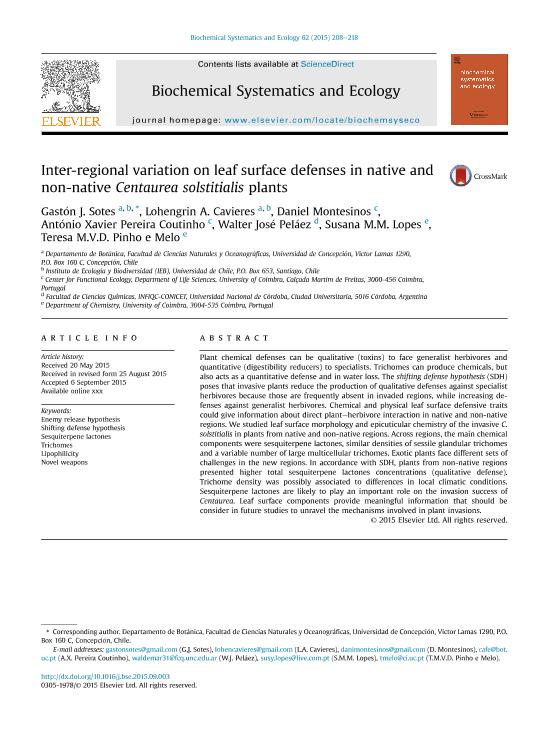Artículo
Inter-regional variation on leaf surface defenses in native and non-native Centaurea solstitialis plants
Sotes, Gastón J.; Cavieres, Lohengrin Alexis; Montesinos, Daniel; Pereira Coutinho, António Xavier; Peláez, Walter José ; Martins Lopes, Susana Margarida; Vasconcelos Dias de Pinho e Melo, Teresa Margarida
; Martins Lopes, Susana Margarida; Vasconcelos Dias de Pinho e Melo, Teresa Margarida
 ; Martins Lopes, Susana Margarida; Vasconcelos Dias de Pinho e Melo, Teresa Margarida
; Martins Lopes, Susana Margarida; Vasconcelos Dias de Pinho e Melo, Teresa Margarida
Fecha de publicación:
07/2015
Editorial:
Pergamon-Elsevier Science Ltd
Revista:
Biochemical Systematics And Ecology
ISSN:
0305-1978
Idioma:
Inglés
Tipo de recurso:
Artículo publicado
Resumen
Plant chemical defenses can be qualitative (toxins) to face generalist herbivores and quantitative (digestibility reducers) to specialists. Trichomes can produce chemicals, but also acts as a quantitative defense and in water loss. The shifting defense hypothesis (SDH) poses that invasive plants reduce the production of qualitative defenses against specialist herbivores because those are frequently absent in invaded regions, while increasing defenses against generalist herbivores. Chemical and physical leaf surface defensive traits could give information about direct plant–herbivore interaction in native and non-native regions. We studied leaf surface morphology and epicuticular chemistry of the invasive C. solstitialis in plants from native and non-native regions. Across regions, the main chemical components were sesquiterpene lactones, similar densities of sessile glandular trichomes and a variable number of large multicellular trichomes. Exotic plants face different sets of challenges in the new regions. In accordance with SDH, plants from non-native regions presented higher total sesquiterpene lactones concentrations (qualitative defense). Trichome density was possibly associated to differences in local climatic conditions. Sesquiterpene lactones are likely to play an important role on the invasion success of Centaurea. Leaf surface components provide meaningful information that should be consider in future studies to unravel the mechanisms involved in plant invasions.
Archivos asociados
Licencia
Identificadores
Colecciones
Articulos(INFIQC)
Articulos de INST.DE INVESTIGACIONES EN FISICO- QUIMICA DE CORDOBA
Articulos de INST.DE INVESTIGACIONES EN FISICO- QUIMICA DE CORDOBA
Citación
Sotes, Gastón J.; Cavieres, Lohengrin Alexis; Montesinos, Daniel; Pereira Coutinho, António Xavier; Peláez, Walter José; et al.; Inter-regional variation on leaf surface defenses in native and non-native Centaurea solstitialis plants; Pergamon-Elsevier Science Ltd; Biochemical Systematics And Ecology; 62; 7-2015; 208-218
Compartir
Altmétricas



